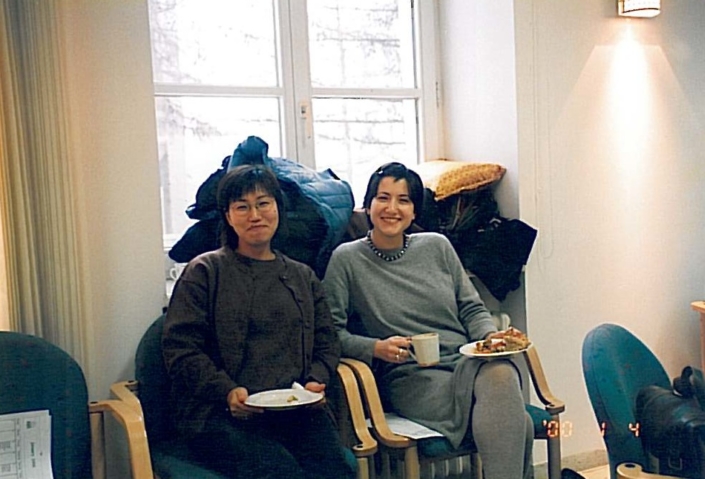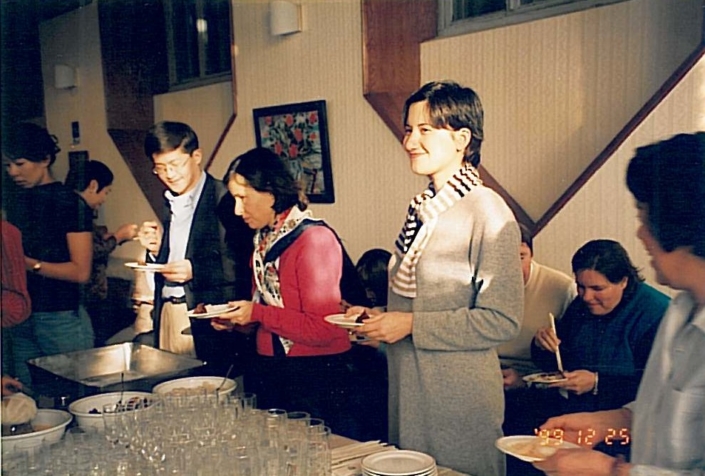Mongolian Weekly News no. 6
Date: December 26, 1999
Dear Friends,
Welcome to the last MWC of the year. I hope the holidays have been going well for you so far. As for UB, Christmas is being celebrated around the relevant pious households and communities, with the appropriate snowy urban landscape to accompany. I know that’s not too likely in locations such as Claire’s current Australia, but I wouldn’t complain! After all, here the weather has warmed in the last two days to only -5 degrees C… I heard it is expected to shoot down to -20 degrees F soon, though, which doesn’t sound too great in Celsius…
Right now, the TV in the living room is on, where also the hapless laptop is located, and a Mongolian-dubbed version of The Mask of Zorro with Hopkins-Banderas- Zeta-Jones is showing, which might lure me away from my imminent task any moment now…
which it did of course..! BBC World, CNN Asia and National Geographic Channel save the day for us here, in terms of television, apart from these occasional films on Mongolian TV, the Korean soap operas and Russian TB6- Mockba.
Anyway… This week has passed by with highlights such as three museum excursions- highly cultural! Only two of which were successful.
The first was to Zanabazar Museum, a fine arts museum exhibiting works by the Great Zanabazar, first leader of Mongolian Buddhism, as well as being a talented sculptor. His copper sculptures of Buddhist deities, especially Tara, the goddess of compassion, are renowned, and can be seen here, along with other fine statues and silk appliques, a refined art from in Mongolia. The museum also had a section on what appeared to be recent, modern installation work, using earth, metal wires, plastic sheeting and coloured water in plastic bags- very original… (In terms of art, there seems to be quite a lot to admire; like mentioned in MWC 5, Mongolian art is in good shape. More on that in the part on the gallery opening.) As to more ‘mobile’ spectacles, a statue in glass casing being carried away by about five of the museum staff (plus their ‘entourage’ comprising their wives and a baby) as I was going around- the only apparent visitor that day, unfortunately- and some more people cheerfully decorating the entrance with shiny Y2000 theme items caught the eye. The souvenir shop was also scene to a mother bundling up her baby while she waited for her husband, who came later and sold an item off to me after a little bargaining, his facial features in direct, honest correlation with the levels of the prices negotiated. Not like that of a calculating merchant…
The next stop two days later was the Natural History Museum, more simply referred to (mistakenly by me) as the Dinosaur Museum. The mistake became clear when I tried to find the museum building by entering a shop called ‘Living Dinosaur Art Shop’ to ask for directions, and no one had heard of a dinosaur museum. Why would they then name their shop that way? Enigmatic… Pushing a couple of mega-streets further along produced the desired address, a giant white classical building with its diagonal entrance façade facing a wide junction. With the regularly sunny weather here, the white takes on a piercing crisp tone. Nice. Inside this museum, apart from an abundance of mysterious minerals and rocks (no foreign language signage in about 90% of the exhibits), typical story-of-man representations, and an impressive collection of animal taxidermies, the paleontological section included interesting plant and bird fossils, dinosaur bones, and a colossal dinosaur skeleton taking up a huge hall, which strangely reminds me of the theatre hall the eccentric architect- Ben Tindall- was decorating in Edinburgh (for the ex-Yorkers, without HIS piercing colours!) Actually, a section of the museum was called The Camel is a Living Dinosaur Museum, but it doesn’t seem to have caught the public’s attention enough to be a commonplace phrase…
As to the unsuccessful third museum expedition, this was undertaken by my mother and me to the Joijin Temple Museum, one of the standing Buddhist temples in the city. After managing to cross the continuous, 1-m-or-so ditch along the whole complex without slipping in, we discovered that was the closed day of the museum, when our question-word ‘Margash’?’ was confirmed with a similar ‘Margash’, which means ‘tomorrow’. Closing days for museums aren’t very consistent, and can be two days in the week as well, so we weren’t too devastated, instead fulfilling feminine appetites for shopping in the nearby exhibition hall, where a bazaar was set up.
After the museum sessions, we can return to the subject of Mongolian art, with the opening of an exhibition in the National Art Gallery, situated like the parliament building on UB’s grand Sukh Baatar Square. (By the way, Ulaan Baatar means Red Hero. For Turkish friends, think of Al as Ulaan, and Bahadır as Baatar. Sukh Baatar, the meaning I don’t know.) This was, from what my father and I gathered, the opening of the section of the gallery celebration the last ten-democratic- years of Mongolian fine art, as the works were grouped under the years 1990 to 1998. Apart from the hosting director of the museum, an overly-self-confident woman (full of herself!) as so many people in high places and arty circles can apparently be- who drew my antipathetic sentiments right away, and a few poorly framed and thus wasted works, there were some jewels like the exquisite wooden carvings on wildlife and folkloric themes- wildlife is still a hugely dominant theme- and some truly beautiful paintings, one of which hypnotized my father, and serious thoughts crossed his mind about buying possibilities, if it weren’t for their state-owned status…
On Saturday (last) night, we were invited to the house of the US Embassy residence for a Christmas dinner. It wouldn’t be surprising to ask how come we were involved, as being Muslims- but I think it was a general social event including particular friendships in it. Other foreigners, namely the Russian Ambassador and his wife (a very nice couple, who contributed to the big Christmas meal with a huge fish dish, i.e. the fresh water inland salmon, wrapped around pastry- very popular among everyone) were also there among the US state personnel and private company members. It was something between a kind of official cocktail, and a cozy community celebration. Our contribution was a bottle of rakı, to add to the already abundant alcoholic selection to enjoy. Festive but not very religious, huh?.. Oh, give us a break..:)
Today, a celebration from a totally different culture was on the agenda, as we attended a Japanese New Year event (if I’m correct) at a hotel, where the Japanese community gathered. The main feature of this event was a combination of a culinary performance and a light lunch. You must probably have heard of grape crushing, but have you heard of RICE crushing?? Well, the Japanese seem to have a custom of putting some well-cooked and softened rice onto a hollowed piece of log- the ‘kine’?- (or maybe that is the Mongolian version, as they cut up an old log from some woods in the countryside to make this apparatus) and smash it in with the great thumps of a wooden giant hammer- the ‘husu’?- accompanied by sounds of ‘eya!’, ‘huyo!’, ‘iha!’ and the like. When the rice becomes dough-like in texture, they take it out and it joins the rest of the dishes on the table, i.e. grated radish, soya powder, and sweet brown paste made of beans. The food was suspect for me owing to previous unpleasant experiences, but the interesting company made up for it: First of all with Professor Hara, a petite old man with a constant smile and laughing eyes who was the one that had invited us; a Dutch gentleman, 25% Japanese owing to a grandmother, who discussed ‘amateur historian’ topics with my father, and told of this family ancestry and its dilemmas during World War II when the Netherlands and Japan were on opposing sides; a gorgeous Israeli lady who told us of her daughter residing in the UK and a strict nutritional militant, eating only brown bread, avocadoes and humus and nothing else, and who was accompanied by her 7-year-old twin sons, Aron and Ariel, very cheeky, charming and bratty boys toasting champagne glasses filled with Sprite with each other, and trying their little hands at the ‘kine’ and husu’. Speaking of siblings, I must mention that Prof. Hara was at least the third person that mistook me for my sister, whom he met when she was here in the summer. I am amazed at this recurring thing, which hardly ever happened to us before. Apart from coincidentally similar hairstyles and some shared mannerisms, I am connecting it to a tendency we can recognize when Caucasian people can’t differentiate between Far Eastern people’s faces. So I guess it can happen the other way around, too!..)
This was followed by a short visit to congratulate a new-born baby, to a Turkish journalist friend, working for UNDP and married to a Mongolian woman. Their ‘shared product’ was a puffy-cheeked little fellow called Cengiz, ambitious but appropriate, since it is both a Turkish and Mongolian name.
So those are the past week’s events. To add some further general observations to these, I should mention the ‘homeotherapeutic’ doctor who comes around to our place regularly, and who has inspected all three of us on different occasion, involving things like milk massages (!), and prescribing physiotherapy-type muscle toning movements. She was a regular doctor before becoming interested in traditional medicine, and now has the capabilities to treat many more things.
I should also comment more on the streets. There is some graffiti sprayed onto buildings, which are worth noting- things you still wouldn’t be likely to see in China- how about ‘Kurt Cobain’, ‘Wu Tang Clan’ and ‘Gangstar’? (Nondas, if I look around a little more, I might even find your suggestion, ‘Chinggis Loves Yun Yun’!! LOL). The motor vehicles continue to be incredibly insensitive toward pedestrians, and pedestrians have no care at all about where they are crossing. Actually, this wouldn’t be much of a shock coming from Turkey or most other Mediterranean cultures, but there aren’t even crossing signs where you would expect them to be. I am sometimes scared to cross, I admit! (Aslı, if you are getting this mail, you must be laughing at me now!) The ‘Dinosaur’ day, a street-car (/cable car, running on overhead electric wires) was almost running me over, and though it was huge, it was also slow enough for me to place a big slap on its side out of my outrage. I hope the driver heard it! The Russian ambassador (Valeri) was telling about this and other habits (or lack of) of these people, stemming from a still-strong nomadic existence. They are rapidly ‘modernizing’, but Valeri and Lidya (Mrs. Amb.) say that maybe it is better not to learn all the rules, and preserve the sources for new approaches to new social problems in the future, which may be more innovative and productive… Well, we’ll see, just don’t make roadkill out of us!
All in all, it’s not bad to get to know the people in Mongolia, with their sharp, dramatic and many times very handsome features, and their direct, frank manners.
That seems to be it for now. See you next year, same time, same place, hopefully! Take care, yours, Ege



